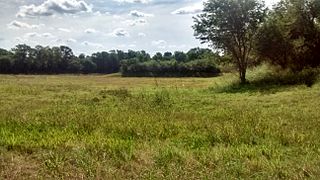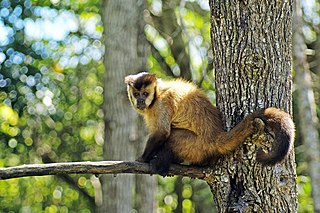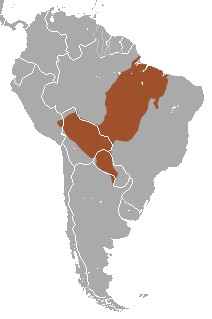
Night monkeys, also known as owl monkeys or douroucoulis, are nocturnal New World monkeys of the genus Aotus, the only member of the family Aotidae. The genus comprises eleven species which are found across Panama and much of South America in primary and secondary forests, tropical rainforests and cloud forests up to 2,400 metres (7,900 ft). Night monkeys have large eyes which improve their vision at night, while their ears are mostly hidden, giving them their name Aotus, meaning "earless".

The gray-bellied night monkey, also called the grey-legged douroucouli or lemurine owl monkey, is a small New World monkey of the family Aotidae. Native to tropical and subtropical forests of South America, the gray-bellied night monkey faces a significant threat from hunting, harvesting for use in pharmaceutical research and habitat destruction.

The black-tailed marmoset is a species of New World monkey from central South America, where it ranges from the south-central Amazon in Brazil, south through the Pantanal and eastern Bolivia, to the Chaco in far northern Paraguay. It is the southernmost member of the genus Mico and the only species where most of its range is outside the Amazon.

The Pampas fox, also known as grey pampean fox, Pampas zorro, Azara's fox, or Azara's zorro, is a medium-sized zorro, or "false" fox, native to the South American Pampas. Azara in some of its alternative common names is a reference to Spanish naturalist Félix de Azara.

The Humid Chaco is tropical grasslands, savannas, and shrublands ecoregion in South America. It lies in the basin of the Paraná River, covering portions of central Paraguay and northern Argentina, and with a small portion of southwestern Brazil and northwestern Uruguay. The natural vegetation is a mosaic of grasslands, palm savanna, and forest.

The black-capped squirrel monkey is a species of New-World monkey native to the upper Amazon basin in Bolivia, western Brazil and eastern Peru. They weigh between 365 and 1,135 g and measure, from the head to the base of the tail, between 225 and 370 mm. Black-capped squirrel monkeys are primarily tree-dwelling and are found in both native and plantation forests as well as some farmed areas near running water. Their diet is omnivorous and mostly consists of flowers, fruit, leaves, nuts, seeds, insects, arachnids, eggs and small vertebrates. They mostly live in female-dominated troops of around 40 to 75 monkeys, with males having been observed to disperse to live in all-male troops after reaching sexual maturation. Their current conservation status according to the IUCN is 'Least Concern'. The species belongs to the genus Saimiri and has two subspecies, S. b. boliviensis and S. b. peruviensis.

The white-eared titi monkey also known as the Bolivian titi or Bolivian gray titi, is a species of titi monkey, a type of New World monkey, from eastern Bolivia and an area of western Brazil. The species has a range that extends east from the Manique River in Beni Department, Bolivia to southern Rondônia in Brazil. The southern end of its range includes forests around the city of Santa Cruz de la Sierra.

The Peruvian night monkey, also known as the Andean night monkey, is a nocturnal New World monkey endemic to northern Peru. Adults weigh around 1 kg (2.2 lb) and measure up to 50 cm (20 in) in length. Its colour is grey to light brown with characteristic black and white markings on the face. The chest, belly and upper arms are orange tinged, however, to a lesser extent then Aotus nigriceps.

Spix's night monkey, also known as the Colombian gray night monkey, noisy night monkey and Spix's owl monkey, is a night monkey species from South America. It is found in Brazil, Colombia, Ecuador and Peru.

The gray brocket, also known as the brown brocket, is a species of brocket deer from northern Argentina, Bolivia, southern Peru, eastern and southern Brazil, Paraguay, and Uruguay. It formerly included the Amazonian brown brocket and sometimes also the Yucatan brown brocket as subspecies. Unlike other species of brocket deer in its range, the gray brocket has a gray-brown fur without reddish tones.

The spectacled owl is a large tropical owl native to the neotropics. It is a resident breeder in forests from southern Mexico and Trinidad, through Central America, south to southern Brazil, Paraguay, and northwestern Argentina. There are six subspecies. One is occasionally treated as a separate species called the short-browed or brown-spectacled owl but the consensus is that it is still merely a race until more detailed analysis can be done.

The Masoala fork-marked lemur, also known as the eastern fork-marked lemur or Masoala fork-crowned lemur, is a species of lemur found in the coastal forests of northeastern Madagascar. It is a small nocturnal animal with large eyes, greyish fur and a long tail.

The Chaco owl is an owl found in Argentina, Bolivia, and Paraguay.

The Chaco chachalaca is a species of bird in the family Cracidae, the chachalacas, guans, and curassows. It is found in Argentina, Bolivia, Brazil, Paraguay, and possibly Uruguay.

The Panamanian night monkey or Chocoan night monkey is a species of night monkey formerly considered a subspecies of the gray-bellied night monkey of the family Aotidae. Its range consists of Panama and the Chocó region of Colombia. There are also unconfirmed reports of its occurrence in Costa Rica, especially on the Caribbean coast of Costa Rica. The species definitely occurs in the Atlantic lowlands of Panama close to the Costa Rica border.

The gray-handed night monkey is a species of night monkey formerly considered a subspecies of Gray-bellied night monkey of the family Aotidae. Its range consists of parts of Colombia and Venezuela. The exact classification of the gray-handed night monkey is uncertain. While some authors consider it a subspecies of the gray-bellied night monkey, A. lemurinus, other authors consider it a separate species, A. griseimembra.

Azaras's capuchin or hooded capuchin is a species of robust capuchin. It occurs in eastern Paraguay, southeastern Bolivia, northern Argentina, and Brazil, at Mato Grosso do Sul and Mato Grosso states, in Pantanal. Its habitat consists of subtropical, humid, semi-deciduous, gallery forests and forested regions of the Pantanals. Formerly, it was considered a subspecies of black-striped capuchin, according to Groves (2005) with the name Cebus libidinosus paraguayanus, but Silva Jr. (2001) considered it a separated species. They are considered as frugivores-insectivores which means that their diet mainly consists of a variety of fruits, seeds, arthropods, frogs, small mammals, etc.
Aotus dindensis is an extinct species of New World monkeys in the genus Aotus from the Middle Miocene. Its remains have been found at the Konzentrat-Lagerstätte of La Venta in the Honda Group of Colombia.

The Botanical Garden and Zoo of Asunción is a botanical garden and zoo located in Asunción, capital of the Republic of Paraguay.



















